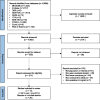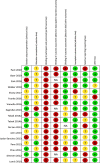Effectiveness of remote home monitoring for patients with Chronic Obstructive Pulmonary Disease (COPD): systematic review
- PMID: 35568904
- PMCID: PMC9107164
- DOI: 10.1186/s12913-022-07938-y
Effectiveness of remote home monitoring for patients with Chronic Obstructive Pulmonary Disease (COPD): systematic review
Abstract
Background: Although remote home monitoring (RHM) has the capacity to prevent exacerbations in patients with chronic obstructive pulmonary disease (COPD), evidence regarding its effectiveness remains unclear. The objective of this study was to determine the effectiveness of RHM in patients with COPD.
Methods: A systematic review of the scholarly literature published within the last 10 years was conducted using internationally recognized guidelines. Search strategies were applied to several electronic databases and clinical trial registries through March 2020 to identify studies comparing RHM to 'no remote home monitoring' (no RHM) or comparing RHM with provider's feedback to RHM without feedback. To critically appraise the included randomized studies, the Cochrane Collaboration risk of bias tool (ROB) was used. The quality of included non-randomized interventional and comparative observational studies was evaluated using the ACROBAT-NRSI tool from the Cochrane Collaboration. The quality of evidence relating to key outcomes was assessed using Grading of Recommendations, Assessment, Development and Evaluations (GRADE) on the following: health-related quality of life (HRQoL), patient experience and number of exacerbations, number of emergency room (ER) visits, COPD-related hospital admissions, and adherence as the proportion of patients who completed the study. Three independent reviewers assessed methodologic quality and reviewed the studies.
Results: Seventeen randomized controlled trials (RCTs) and two comparative observational studies were included in the review. The primary finding of this systematic review is that a considerable amount of evidence relating to the efficacy/effectiveness of RHM exists, but its quality is low. Although RHM is safe, it does not appear to improve HRQoL (regardless of the type of RHM), lung function or self-efficacy, or to reduce depression, anxiety, or healthcare resource utilization. The inclusion of regular feedback from providers may reduce COPD-related hospital admissions. Though adherence RHM remains unclear, both patient and provider satisfaction were high with the intervention.
Conclusions: Although a considerable amount of evidence to the effectiveness of RHM exists, due to heterogeneity of care settings and the low-quality evidence, they should be interpreted with caution.
Keywords: COPD; Home-based; Remote monitoring; Systematic review.
© 2022. The Author(s).
Conflict of interest statement
None declared.
Figures







Similar articles
-
Effectiveness of home-based pulmonary rehabilitation programs for patients with chronic obstructive pulmonary disease (COPD): systematic review.BMC Health Serv Res. 2022 Apr 26;22(1):557. doi: 10.1186/s12913-022-07779-9. BMC Health Serv Res. 2022. PMID: 35473597 Free PMC article.
-
Association of Home Noninvasive Positive Pressure Ventilation With Clinical Outcomes in Chronic Obstructive Pulmonary Disease: A Systematic Review and Meta-analysis.JAMA. 2020 Feb 4;323(5):455-465. doi: 10.1001/jama.2019.22343. JAMA. 2020. PMID: 32016309 Free PMC article.
-
Does health coaching improve health-related quality of life and reduce hospital admissions in people with chronic obstructive pulmonary disease? A systematic review and meta-analysis.Br J Health Psychol. 2019 Sep;24(3):515-546. doi: 10.1111/bjhp.12366. Epub 2019 Apr 29. Br J Health Psychol. 2019. PMID: 31033121 Free PMC article.
-
The future of Cochrane Neonatal.Early Hum Dev. 2020 Nov;150:105191. doi: 10.1016/j.earlhumdev.2020.105191. Epub 2020 Sep 12. Early Hum Dev. 2020. PMID: 33036834
-
Community-based care for the specialized management of heart failure: an evidence-based analysis.Ont Health Technol Assess Ser. 2009;9(17):1-42. Epub 2009 Nov 1. Ont Health Technol Assess Ser. 2009. PMID: 23074521 Free PMC article.
Cited by
-
Early Identification of Exacerbations in Patients with Chronic Obstructive Pulmonary Disease (COPD).J Clin Med. 2025 Jan 10;14(2):397. doi: 10.3390/jcm14020397. J Clin Med. 2025. PMID: 39860403 Free PMC article. Review.
-
Increasing exercise capacity and physical activity in the COPD patient.Breathe (Sheff). 2024 Jun 11;20(2):230347. doi: 10.1183/20734735.0347-2023. eCollection 2024 Jun. Breathe (Sheff). 2024. PMID: 38873235 Free PMC article. Review.
-
Health inequity: Possibilities of initiating pulmonary telerehabilitation programs for adults with chronic obstructive pulmonary disorders in conflict and low-resourced areas; A mixed-method phenomenological study.PLoS One. 2025 May 29;20(5):e0324624. doi: 10.1371/journal.pone.0324624. eCollection 2025. PLoS One. 2025. PMID: 40440329 Free PMC article.
-
MSCs regulate oxidative stress through the Nrf2 pathway to treat chronic obstructive pulmonary disease.BMC Pulm Med. 2025 Jul 2;25(1):304. doi: 10.1186/s12890-025-03770-2. BMC Pulm Med. 2025. PMID: 40604620 Free PMC article.
-
Effectiveness of Digital Health Interventions for Chronic Obstructive Pulmonary Disease: Systematic Review and Meta-Analysis.J Med Internet Res. 2025 May 26;27:e76323. doi: 10.2196/76323. J Med Internet Res. 2025. PMID: 40418567 Free PMC article.
References
-
- Global initiative for Chronic Obstructive Lung Disease . Global Strategy for the Diagnosis, Managment, and Prevention of Chronic Obstructive Pulmonary Disease (2019 Report) 2019.
-
- Barnes PJ, Celli BR. Systemic manifestations and comorbidities. 2009;33(5):1165-1185. doi:10.1183/09031936.00128008 - PubMed
Publication types
MeSH terms
LinkOut - more resources
Full Text Sources
Medical

